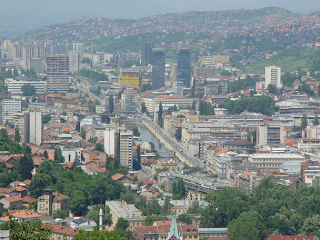
Bosnia and Herzegovina (Bosnian, Croatian, Serbian Latin: Bosna i Hercegovina; Serbian Cyrilic: Босна и Херцеговина) is a country on the Balkan peninsula of South Eastern Europe with an area of 51,129 square kilometres (19,741 sq mi). Bordered by Croatia to the north, west and south, Serbia to the east, and Montenegro to the south, Bosnia and Herzegovina is almost landlocked, except for 26 kilometres of the Adriatic Sea coastline, centered around the town of Neum.[2][3] The interior of the country is mountainous in the center and south, hilly in the northwest, and flat in the northeast. It is the largest geographic region of the modern state with moderate continental climate, marked by hot summers and cold, snowy winters. Smaller Herzegovina is the southern tip of the country, with Mediterranean climate and topography. Bosnia and Herzegovina's natural resources are highly abundant.
The country is home to three ethnic "constituent peoples": Bosniaks, the most numerous population group of Bosnia, with Serbs in second and Croats in third. Regardless of ethnicity, a citizen of Bosnia and Herzegovina is often identified in English as a Bosnian. In Bosnia, the distinction between a Bosnian and a Herzegovinian is maintained as a regional, rather than an ethnic distinction. The country is politically decentralized and comprises two governing entities, the Federation of Bosnia and Herzegovina and Republika Srpska, with District Brčko as a de facto third entity.
Formerly one of the six federal units constituting the Socialist Federal Republic of Yugoslavia, Bosnia and Herzegovina gained its independence during the Yugoslav wars of the 1990s. Bosnia and Herzegovina can be described as a federal democratic republic that is transforming its economy into a market-oriented system, and it is a potential candidate for membership in the European Union and NATO. Additionally, Bosnia and Herzegovina is a founding member of the
HISTORY
Bosnia has been inhabited at least since the Neolithic age. In the early Bronze Age, the Neolithic population was replaced by more warlike Indo-European tribes known as the Illyres or Illyrians. Celtic migrations in the fourth century BC and third century BC displaced many Illyrian tribes from their former lands, but some Celtic and Illyrian tribes mixed. Concrete historical evidence for this period is scarce, but overall it appears that the region was populated by a number of different peoples speaking distinct languages. Conflict between the Illyrians and Romans started in 229 BC, but Rome would not complete its annexation of the region until AD 9. In the Roman period, Latin-speaking settlers from all over the Roman empire settled among the Illyrians and Roman soldiers were encouraged to retire in the region.[4]
The land originally was part of the Illyria up until the Roman occupation. Following the split of the Roman Empire between 337 and 395, Dalmatia and Pannonia became parts of the Western Roman Empire. Some claim that the region was conquered by the Ostrogoths in 455. It subsequently changed hands between the Alans and Huns. By the sixth century, Emperor Justinian had reconquered the area for the Byzantine Empire. The Slavs, a people from eastern Europe (now territory of Ukraine), were conquered by the Avars in the sixth century.
SPORT
The most important international sporting event in the history of Bosnia and Herzegovina was the hosting of the, 14th Winter Olympics held in Sarajevo from the 7th to February 19, 1984.
Bosnia and Herzegovina has produced many athletes. Many of them were famous in the Yugoslav national teams before Bosnia and Herzegovina's independence.
Some notable local Olympians were:
- Rome, 1960: Tomislav Knez and Velimir Sombolac (football),
- Munich, 1972: Abaz Arslanagić, Milorad Karalić, Nebojša Popović, Đorđe Lavrinić, Dobrivoje Seleć (handball)
- Moscow, 1980: Mirza Delibašić and Ratko Radovanović (basketball)
- Los Angeles, 1984: Zdravko Rađenović, Zlatan Arnautović (handball) and Anto Josipović (boxing).
| Capital (and largest city) | Sarajevo | |
| Official languages | Bosnian, Croatian and Serbian | |
|---|---|---|
| Ethnic groups (2002) | Bosniaks: 70% Croats: 28% Serbs: 1% | |
| Government | Parliamentary system | |
| - | President | Borjana Krišto |
| - | Prime Minister | Nedžad Branković |
| Entity of Bosnia and Herzegovina | Entity of Bosnia and Herzegovina | |
| - | Formed | 18 March 1994 |
| - | Recognized in Bosnia and Herzegovina constitution | 14 December 1995 |
| Area | ||
| - | Total | 26,110.5 km2 10,085 sq mi |
| - | Water (%) | N/A |
| Population | ||
| - | 2007 estimate | 2,849,306[1] |
| - | 1996 census | 2,444,6652 |
| - | Density | 117/km2 303.86/sq mi |
| Currency | Convertible Mark (BAM) | |
| Time zone | CET (UTC+1) | |
| - | Summer (DST) | CEST (UTC+2) |
| Drives on the | right | |



1 comment:
I've been there for spring holidays and I must say, that I was positive suprised. Bosnias are very nice people and also the landscape is very beautiful. I hope I'll soon see the country again.=)
Post a Comment